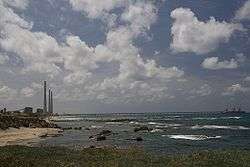Orot Rabin
| Orot Rabin Power Station | |
|---|---|
 Orot Rabin power plant and its coal pier, viewed from Caesarea Maritima | |
| Country | Israel |
| Location | Hadera |
| Coordinates | 32°28′12″N 34°53′22″E / 32.47°N 34.8895°ECoordinates: 32°28′12″N 34°53′22″E / 32.47°N 34.8895°E |
| Status | Operational |
| Construction began | 1973 |
| Commission date | 1981 |
| Owner(s) | IEC |
| Thermal power station | |
| Primary fuel | Coal |
| Secondary fuel | Fuel oil |
| Tertiary fuel | Crude oil |
| Power generation | |
| Units operational |
4 × 375 MW 2 × 575 MW |
| Make and model |
Babcock & Wilcox ABB GE MAN |
| Nameplate capacity | 2,590 MW |
Orot Rabin (Hebrew: אורות רבין, lit. Rabin Lights) is a coal-fired power station situated on the Mediterranean coast in Hadera, Israel. It is owned and operated by the Israel Electric Corporation (IEC).
History
Construction of the station began in 1973 and block 1 (steam boiler, turbine and generator units 1-4) began operating in stages between 1981 and 1984. A second generation block (boiler, turbine and generator units 5-6) came online in 1996. A coal port is attached directly to the station which supplies all its coal consumption needs. Its total generating capacity is 2,590MW of electricity using the six power generating units (composed of two large units and four smaller units) located at the site. The plant's overall design can accommodate two additional large generation units which could be built at a future date.
Originally the power station was named Maor David after David Shiffman, then-chairman of the IEC who died during its lengthy period of construction. However, after the completion of a major expansion of the station in the 1990s and the assassination of Yitzhak Rabin, the station was renamed in his honor to Orot Rabin, Hebrew for "Rabin Lights".
Technical description
As of 2016 the plant is Israel's largest power station with its 2,590 MW representing about 19% of the Israel Electric Corporation's total generation capacity (that is, unless Phase D expansion at the Rutenberg Power Station in Ashkelon will be built, at which point the latter would surpass Orot Rabin as Israel's largest power station). The plant burns 18,000 tons of coal every 24 hours and uses 320,000 tons of seawater every hour.[1] It is also possible to operate the station using fuel oil. In 2009, a large desalination plant was built adjacent to the power station. In the mid 2010s, a fourth flu stack coupled with a scrubber (for FGD) and additional pollution control devices were connected to generation block 2 of the station, significantly reducing the amount of particulate pollution emanating from the block.
Flue-gas stack 3 of the power station is 300 metres (980 ft) tall, making it Israel's second-tallest structure after the towers of the Dimona Radar Facility, although stack 3 is no longer used since the construction of flu stack 4.
Future operation
In 2016 the Israeli Ministry of Energy announced that it intends to instruct the IEC to shut down and mothball the older block 1 (generation units 1-4) of the station in the early the 2020s. Unlike block 2, as well as both generation blocks of the Rutenberg coal plant, a scrubber has not been fitted to Orot Rabin’s block 1 and as such block 1 produces about 25% of the total main particulates pollution generated by all sources in the entire state of Israel.
The block’s production capacity will be replaced by future natural gas operated combined cycle power plants, at least one of which is expected to be built in the space originally reserved for additional coal units in the northern part of the Orot Rabin site. Although shut down, units 1-4 will continue to be maintained so that they may be restarted in case of emergency (such as an extended disruption in the domestic supply of natural gas).
Environmental issues
Orot Rabin has been accused of polluting the nearby Hadera Stream.[2] Greenpeace claims that the station pollutes the sea water when coal is unloaded from ships and the sea water used for cooling the plant ends up in the Hadera River which harms wildlife.[1]
References
- 1 2 Paz, Shelley (2007-03-01). "Greenpeace Protests at Hadera Power Plant". The Jerusalem Post. Retrieved 2013-09-15.
- ↑ Ashkenazy, Daniella (2008-09-17). "Hadera's lost lagoons". The Jerusalem Post. Retrieved 2013-09-15.
| Wikimedia Commons has media related to Orot Rabin. |